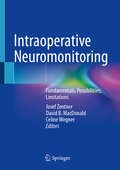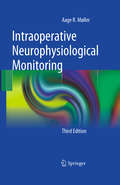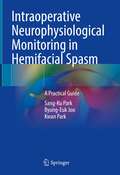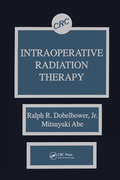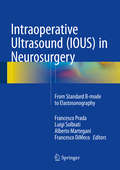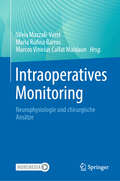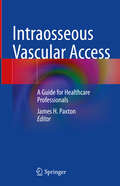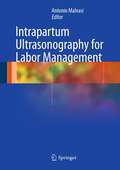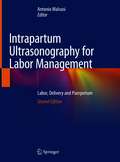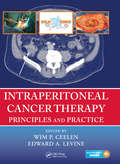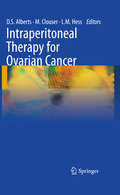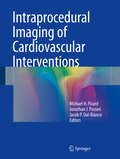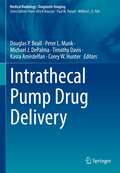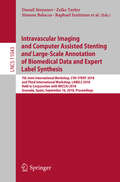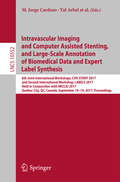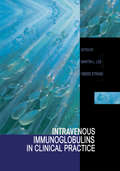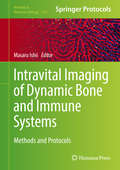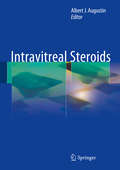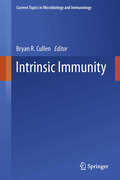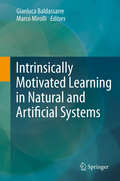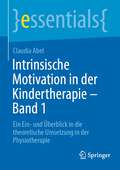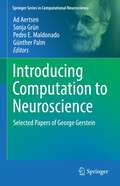- Table View
- List View
Intraoperative Neuromonitoring: Fundamentals, Possibilities, Limitations (Issn Ser.)
by Josef Zentner David B. MacDonald Celine WegnerIntraoperative neurophysiological monitoring (IONM) has gained increasing interest during the past decades and is now an integral part of various surgical disciplines, especially in neurosurgery, but also in otolaryngology, orthopedics, vascular surgery and general surgery. With expanding applications and evolving techniques, the monitoring team is faced with increasingly complex tasks and responsibilities. Despite its importance and significance in modern surgical medicine and the expectations associated with it, IONM is still not a regular part of the training program of medical professionals. Although knowledge on monitoring is imparted in basic courses offered by a few professional societies, systematic training of medical and non-medical staff according to a standardized curriculum is still lacking.This book aims to contribute to closing this gap. It provides a practical guide to help medical, nursing, and technical personnel get familiar with intraoperative neuromonitoring. The basic tenor is to combine theoretical and practical knowledge and thus to systematically convey essential skills about fundamentals, possibilities, but also limitations of IONM to a broad circle of readers. In order to achieve this goal, the text has been reduced to the absolutely necessary length in favor of numerous illustrations and tables.After an introduction to the tasks, the significance, and the historical development of IONM, the anatomical, physiological and physical basics are presented. This is followed by a presentation of various modalities as well as stimulation and recording techniques. The intraoperative part begins with some information on the organizational processes in the operating room, the presentation of safety aspects, and a description of the influences of anesthesia on monitoring, including the special aspects of awake surgery. This is followed by some basic remarks on the interpretation of monitoring results and a rough overview of the application fields of IONM in various disciplines including representative case examples. The manual concludes with an evaluation of the efficiency of monitoring and practical recommendations for the detection and elimination of intraoperative sources of error. Self-tests in individual chapters are intended to give readers the opportunity to determine their level of knowledge.
Intraoperative Neurophysiologic Monitoring
by Gloria M. Galloway Marc R. Nuwer Khaled M. Zamel Jaime R. LopezIntraoperative neurophysiologic monitoring has shown a steady increase in use for surgeries in which neural structures may be at risk of injury. Some of the surgical techniques used carry inherent risks, and these risks have changed the way in which neurophysiologic monitoring has impacted patient safety and quality of care during surgical procedures. It is therefore crucial that those performing and interpreting intraoperative neurophysiologic monitoring are adequately trained. This book is a comprehensive guide to the current practice of intraoperative neurophysiology with chapters on various modalities and clinical uses. Separate chapters devoted to anesthesia, operating room environment, special considerations in pediatrics and the interpretation and reporting of neurophysiologic data are useful and complementary. Questions and detailed answers on the topics covered can be found on the accompanying website for study review. This book will be useful to the trainee as well as the neurophysiologist already in practice.
Intraoperative Neurophysiological Monitoring
by Aage R. MøllerThe third edition of this classic text again provides practical, comprehensive coverage of the anatomical and physiological basis for intraoperative neurophysiological monitoring. Written by a leading authority in the field, Dr. Aage Moller has updated this important title to again offer all the leading-edge knowledge needed to perform electrophysiological recordings in the operating room, to interpret the results, and to present the results to the surgeon. The field known as "intraoperative monitoring" has expanded rapidly to cover other uses of neurophysiology and electrophysiologic recordings during surgical operations that affect the brain, spinal cord, and other parts of the nervous system. These new areas are covered in this new edition. To better represent the content of the book and the field as it now stands, many of the chapters have been revised and new material has been added. While the general organization of the book is maintained, chapters such as monitoring of motor systems have been revised and extended with new material, including more detailed description of the anatomy and physiology of motor systems and new information about intraoperative monitoring.
Intraoperative Neurophysiological Monitoring in Hemifacial Spasm: A Practical Guide
by Kwan Park Sang-Ku Park Byung-Euk JooThis book is a comprehensive and up-to-date guide to intraoperative neurophysiological monitoring in patients with hemifacial spasm, one of the very few neuromuscular disorders that can be treated surgically. It covers various aspects including brainstem auditory evoked potentials, lateral spread response, free-running EMG and prognosis, and intraoperative hearing loss patterns. In particular, we present detailed explanations and realistic pictures of various and subtle changes in the waveform of brainstem auditory evoked potentials and postoperative hearing. In addition, detailed explanations and actual photos are provided for various cases, such as when the amplitude of the lateral spread response is slightly smaller during surgery, when it is lost and then measured again, or when the surgery is terminated without disappearing. The various situations that may occur during surgery are fully covered, and the causes of and solutions to particular challenges are clearly described. In addition, the results of each test and their association with the postoperative prognosis are explained in detail. The authors have vast experience and recognized expertise in the performance of microvascular decompression surgery and intraoperative neuromonitoring. The book draws on their practical knowledge and many scientific contributions to offer the very latest insights into the management of hemifacial spasm. It will be an excellent guide for young neurosurgeons, neurological monitoring technologists, and neurological interpreters.
Intraoperative Radiation Therapy
by Ralph R. Dobelbower Jr. Mitsuyuki AbeA comprehensive review of intraoperative radiation therapy, beginning with the rationale for innovative treatment and the radiobiology of single doses. Problems encountered in modifying a linear accelerator and a radiation therapy suite are reviewed in detail along with special problems relating to technology, nursing, anesthesiology, and various s
Intraoperative Ultrasound (IOUS) in Neurosurgery
by Francesco Prada Luigi Solbiati Alberto Martegani Francesco DimecoThis book is intended as a practical manual on the use of intraoperative ultrasound (IOUS) as a tool for imaging guidance during cranial and spinal neurosurgical procedures. Full account is taken of the emergence of novel clinical applications and recent technical advances, with extensive coverage of the impact of developments such as improved probe technology, fusion imaging and virtual navigation, 3D ultrasound imaging, contrast-enhanced ultrasound, and elastosonography. Basic principles of ultrasound are elucidated in order to assist in the optimal use of IOUS and clear guidance is provided on the interpretation of imaging findings in various pathologies. Informative comparisons are also made of the use of techniques such as fusion imaging and contrast-enhanced ultrasound in general radiology and neurosurgery. The aim of the authors is to enhance the general knowledge regarding intra-operative ultrasound brain imaging, standardizing its use and exploring new techniques, leading in some way toward compensating the lack of specific training in the application of ultrasound among theneurosurgical community. IOUS is a sensitive tool that can improve surgical precision and help to reduce morbidity.
Intraoperatives Monitoring: Neurophysiologie und chirurgische Ansätze
by Maria Rufina Barros Marcos Vinicius Calfat Maldaun Silvia Mazzali-VerstIn den letzten Jahrzehnten waren die Fortschritte und die Konsolidierung des intraoperativen neurophysiologischen Monitorings (IOM) in mehreren hochkomplexen chirurgischen Bereichen offensichtlich. Derzeit werden alle Modalitäten neurophysiologischer Tests (SSEP, MEP, EMG, PEATC, VEP, BRAIN MAPPING, ETC) im Operationssaal durchgeführt, wo sie dazu dienen, transoperative Informationen über den neurologischen Status des Patienten in Echtzeit zu liefern (Monitoring) und neurale Strukturen zu identifizieren, die unmittelbar gefährdet sind (Mapping). Mit der unbestreitbar positiven Auswirkung des IOM auf die chirurgischen Ergebnisse gibt es ein zunehmendes Interesse an zuverlässiger, technisch fokussierter Literatur. Dieser Band bietet aktuelle Informationen im Bereich des IOM und hebt neue neurophysiologische Instrumente hervor, die in verschiedenen Operationen verwendet werden. Die Anfangsabschnitte des Buches behandeln eine Reihe von Themen, einschließlich eines anatomischen Überblicks, der elektrischen Sicherheit und detaillierter technischer Beschreibungen der im IOM verwendeten neurophysiologischen Tests. Die nachfolgenden Abschnitte befassen sich z.B. mit dem Gehirn, Hirnstamm, Rückenmark, vaskulären und peripheren Nerven, Epilepsie, Kopf- und Halsbereich, Bewegungsstörungen und speziellen Themen. Einige Kapitel sind begleitet von Videos zu Operationen und IOM, sodass der Leser das echte Gefühl hat, im Operationssaal gewesen zu sein, und einen Überblick über die wichtigsten Schritte erhält. Geschrieben von Experten im Bereich des IOM, bietet das Buch eine wertvolle Ressource sowohl für Erfahrene als auch für Berufseinsteiger in der Neurophysiologie, Neurochirurgen, Gefäß- und Orthopädische Chirurgen sowie für Chirurgen, die an Beckenoperationen beteiligt sind. Weiterhin ist es das Ziel, eine bisher nie erreichte echte Beziehung zwischen Neurophysiologen und Chirurgen zu schaffen mit einem einzigen Fokus: Exzellenz in Bezug auf das Endergebnis.
Intraosseous Vascular Access: A Guide for Healthcare Professionals
by James H. PaxtonThis book summarizes nearly a century of accumulated knowledge on therapeutic intraosseous (IO) access into a concise and well-written review. The emergent infusion of fluids and medications through the IO route can be lifesaving for patients experiencing cardiac arrest, respiratory failure, and other life-threatening medical conditions. Unfortunately, many providers lack the anatomic, therapeutic, and procedural knowledge needed to deploy these devices safely and effectively in critically ill patients. Written for a mixed audience of healthcare professionals, the book opens with an introduction to the relevant anatomy and physiology for those unfamiliar with IO infusion before moving into more advanced topics. The authors cite up-to-date literature on a variety of essential topics, including device and access site selection, decision-making, fluid infusion flow rates, limits of IO technology, compatible medications, complications, pain, and relative contraindications to IO infusion. The book closes with a discussion of the future of IO vascular access and the questions that will guide future research. Intraosseous Vascular Access: A Guide for Healthcare Professionals is an indispensable reference for any healthcare provider, especially patient care technicians, nurses, medical students, resident physicians, practicing clinicians (including ED, ICU, and floor medicine doctors), and EMS paramedics who place and manage IO catheters.
Intrapartum Care for the MRCOG and Beyond
by Sabaratnam Arulkumaran Thomas F BaskettThis book provides a comprehensive overview of clinical intrapartum care, with an emphasis on a pragmatic approach which promotes the necessary vigilant care while also supporting the wishes of the pregnant woman who wants minimal interference. This second edition has been thoroughly updated to reflect current practice and developments in the field since publication of the first edition, with six new chapters added on topics that are of increasing importance: improving intrapartum care, lower genital tract trauma, emergency obstetric hysterectomy, acute uterine inversion, disseminated intravascular coagulation and acute tocolysis. The book is primarily designed to provide a comprehensive summary for candidates preparing for the Part 2 MRCOG examination, and as such covers the RCOG curriculum for intrapartum care. It is also a valuable guide for all healthcare professionals working in the field, including trainees, consultants and midwives.
Intrapartum Ultrasonography for Labor Management
by Antonio MalvasiDuring intrapartum obstetric care clinicians evaluate the fetal head position manually, either by abdominal or digital vaginal palpation. However, digital examination has been shown to be highly operator-dependent (subjective). Intrapartum ultrasound, on the other hand, seems to be reproducible and easy to learn. In crucial situations like obstructed labor, likely to require medical intervention, there really is a need for ultrasound assessment of birth progress and on the busy labor ward. This is the first book devoted entirely to intrapartum ultrasound for the management of labor. Experts in the field present their own experiences and summarize the published state of the art. The use of intrapartum ultrasonography in evaluation of the first and second stages of labor and diagnosis of the occiput posterior and transverse positions is clearly documented. Each situation is analyzed with the help of informative images, and invaluable tips and tricks are provided, showing how fetal head engagement and progression can be documented objectively. The importance of ultrasound in obstetrics risk management is also addressed. This book explains how intrapartum ultrasonography can be used to assess whether a safe natural delivery is likely or whether operative procedures are required. We hope it will be valuable for all professionals, physicians and midwifes alike, who care for labouring women.
Intrapartum Ultrasonography for Labor Management: Labor, Delivery and Puerperium
by Antonio MalvasiThis updated book is a practical guide to intrapartum ultrasonography to help practitioners improve labor and delivery, and to limit, where possible, complications. Presenting the authors’ experiences, the book summarizes the state of the art in normal and abnormal labor. It clearly documents the use of intrapartum ultrasonography to evaluate the first and second stages of labor and diagnose the occiput posterior and transverse positions. Each situation is analyzed with the help of numerous informative images and invaluable tips and tricks showing how fetal head engagement and progression can be documented objectively. The importance of ultrasound in obstetrics risk management is also addressed. Explaining how intrapartum ultrasonography can be used to assess whether a safe natural delivery is likely or whether operative procedures are required, the book is a valuable resource for all professionals – physicians and midwifes alike – caring for women in labor.
Intraperitoneal Cancer Therapy: Principles and Practice
by Edward Levine Wim CeelenIntraperitoneal Cancer Therapy: Principles and Practice is one of the first books to combine the latest clinical developments in the treatment of patients with peritoneal surface disease and the scientific principles that underlie the concept of intraperitoneal cancer therapy. The book covers basic concepts such as anatomy, physiology, pharmacology
Intraperitoneal Therapy for Ovarian Cancer
by Lisa M. Hess Mary C. Clouser David AlbertsIntraperitoneal chemotherapy is increasingly being used as first-line treatment for ovarian cancer. Nevertheless, it is difficult for the oncologist to find a definitive text that documents both the fundamental methods required to optimize therapy and the up-to-date results of phase I, II, and III clinical trials. With this in mind, the editors of Intraperitoneal Chemotherapy have assembled a team of highly experienced clinicians and researchers to cover every aspect of the subject. The topics addressed include treatment principles, patient, drug, and catheter selection, administration guidelines, the role of hyperthermia, supportive care requirements, novel drugs, and the most recent results of clinical trials. This book will be an invaluable source of information for both practicing clinical oncologists and oncologists in training.
Intraprocedural Imaging of Cardiovascular Interventions
by Michael H. Picard Jonathan J. Passeri Jacob P. Dal-BiancoThis book teaches the key knowledge required for the use of ultrasound to guide many catheter based cardiac therapies. While live CME courses are now covering this material there are very few textbooks on this topic. A unique aspect ofthis book is that it has many images to illustrate the teaching points. The use of minimally invasive treatments ofmany cardiac diseases especially by catheter based therapies and devices is arapidly expanding discipline in cardiology and radiology. Cardiac ultrasound particularlyechocardiography is utilized extensively to guide these therapies. Many echocardiographers are being called uponto guide these therapies but they have not been trained in this unique use ofechocardiography.
Intrathecal Pump Drug Delivery (Medical Radiology)
by Timothy Davis Douglas P. Beall Peter L. Munk Michael J. DePalma Kasra Amirdelfan Corey W. HunterThis book is a comprehensive guide to Targeted Drug Delivery (TDD), also known as Intrathecal Drug Delivery (IDD), and offers an overview to this unique form of treatment. The medication is delivered by intrathecal pumps and is less common than some other techniques for interventional pain management, but is essential in conditions such as refractory pain, cancer pain, multifocal pain, severe spasticity, and in patients who are not candidates for surgical correction of their underlying condition. This book is the first source to describe both the optimal surgical implantation and patient management aspect of this therapy, and thus will be a valuable single reference guide for interventional radiologists, anesthesiologists, physiatrists, oncologists, neurologists, spine surgeons, palliative care physicians, and primary care physicians.
Intravascular Imaging and Computer Assisted Stenting and Large-Scale Annotation of Biomedical Data and Expert Label Synthesis: 7th Joint International Workshop, CVII-STENT 2018 and Third International Workshop, LABELS 2018, Held in Conjunction with MICCAI 2018, Granada, Spain, September 16, 2018, Proceedings (Lecture Notes in Computer Science #11043)
by Emanuele Trucco Eric Granger Pierre Jannin Su-Lin Lee Diana Mateus Lena Maier-Hein Veronika Cheplygina Simone Balocco Guillaume Zahnd Stefanie Demirci Luc Duong Shadi Albarqouni Danail Stoyanov Zeike Taylor Anne Martel Raphael Sznitman Stefano MoriconiThis book constitutes the refereed joint proceedings of the 7th Joint International Workshop on Computing and Visualization for Intravascular Imaging and Computer Assisted Stenting, CVII-STENT 2018, and the Third International Workshop on Large-Scale Annotation of Biomedical Data and Expert Label Synthesis, LABELS 2018, held in conjunction with the 21th International Conference on Medical Imaging and Computer-Assisted Intervention, MICCAI 2018, in Granada, Spain, in September 2018. The 9 full papers presented at CVII-STENT 2017 and the 12 full papers presented at LABELS 2017 were carefully reviewed and selected. The CVII-STENT papers feature the state of the art in imaging, treatment, and computer-assisted intervention in the field of endovascular interventions. The LABELS papers present a variety of approaches for dealing with few labels, from transfer learning to crowdsourcing.
Intravascular Imaging and Computer Assisted Stenting, and Large-Scale Annotation of Biomedical Data and Expert Label Synthesis
by Eric Granger Su-Lin Lee M. Jorge Cardoso Gustavo Carneiro Diana Mateus Tal Arbel Lena Maier-Hein Veronika Cheplygina Simone Balocco Guillaume Zahnd Stefanie Demirci Luc Duong Marc-André Carbonneau Shadi AlbarqouniThis book constitutes the refereed joint proceedings of the 6th Joint International Workshop on Computing and Visualization for Intravascular Imaging and Computer Assisted Stenting, CVII-STENT 2017, and the Second International Workshop on Large-Scale Annotation of Biomedical Data and Expert Label Synthesis, LABELS 2017, held in conjunction with the 20th International Conference on Medical Imaging and Computer-Assisted Intervention, MICCAI 2017, in Québec City, QC, Canada, in September 2017. The 6 full papers presented at CVII-STENT 2017 and the 11 full papers presented at LABELS 2017 were carefully reviewed and selected. The CVII-STENT papers feature the state of the art in imaging, treatment, and computer-assisted intervention in the field of endovascular interventions. The LABELS papers present a variety of approaches for dealing with few labels, from transfer learning to crowdsourcing.
Intravenous Immunoglobulins in Clinical Practice
by Vibeke Strand Martin L LeeRecognizing the explosive growth in information on intravenous immunoglobulins (IVIGs), this exhaustive single-source volume surveys all available literature on the employment of IVIG preparations in clinical practice from pharmacoeconomics and pharmacokinetics to prophylaxis and management of infectious and autoimmune diseases.
Intravital Imaging of Dynamic Bone and Immune Systems: Methods And Protocols (Methods In Molecular Biology #1763)
by Masaru IshiiThis detailed volume presents a number of chapters that will aid researchers in jumping the hurdle preventing the popularization of advanced intravital imaging technology usage, namely the complicated experimental protocols. Leading researchers undertaking imaging studies in the field of bone and immune systems have contributed the chapters that aim to guide readers through these complex methodologies. Written for the highly successful Methods in Molecular Biology series, chapters include introductions to their respective topics, lists of the necessary materials and reagents, step-by-step, readily reproducible laboratory protocols, and tips on troubleshooting and avoiding known pitfalls. Authoritative and practical, Intravital Imaging of Dynamic Bone and Immune Systems: Methods and Protocols will serve as an idea guide for general readers in order to establish and perform these experiments by their own.
Intravitreal Steroids
by Albert J. AugustinThis book explains how to use intravitreal steroids optimally in the management of patients with intraocular inflammation (uveitis) and macular edema. The rationale for this treatment approach is first explained by examining the pathophysiology of these disease entities, with particular attention to the major role of inflammatory processes. Devices for the delivery of steroids to the eye are discussed, and guidance provided on the role of imaging studies before, during, and after steroid therapy. The value of different steroidal approaches is then considered in detail. Other topics addressed include the use of steroids as a surgical adjunct and within a combination strategy. Uveitis and macular edema are common sight-threatening diseases or complications of diabetes and retinal vein occlusion for which no adequate treatment was available until recently. Both trainees and practitioners will find Intravitreal Steroids to be an invaluable aid in combating these blinding diseases.
Intrinsic Immunity
by Bryan R. CullenRecent research has focused attention on the importance of intrinsic antiviral immunity, i.e. immunity mediated by factors that are constitutively expressed in many cells. In this volume, leading experts provide a comprehensive overview of this relatively new and rapidly evolving field. They cover intrinsic proteinaceous antiviral immune effectors, such as the APOBEC3 and TRIM protein families as well as Tetherin and SAMHD1, which were initially discovered by researchers studying HIV-1. Furthermore, the role of RNA interference in antiviral defense in plants and invertebrates, as well as the interplay between microRNAs and viruses in mammalian cells, are analysed. One chapter discusses how intrinsic immunity and viral countermeasures to intrinsic immune effectors drive both pathogen and host evolution, and finally the emerging evidence that DNA damage response proteins restrict infection by DNA viruses is highlighted.
Intrinsically Motivated Learning in Natural and Artificial Systems
by Marco Mirolli Gianluca BaldassarreIt has become clear to researchers in robotics and adaptive behaviour that current approaches are yielding systems with limited autonomy and capacity for self-improvement. To learn autonomously and in a cumulative fashion is one of the hallmarks of intelligence, and we know that higher mammals engage in exploratory activities that are not directed to pursue goals of immediate relevance for survival and reproduction but are instead driven by intrinsic motivations such as curiosity, interest in novel stimuli or surprising events, and interest in learning new behaviours. The adaptive value of such intrinsically motivated activities lies in the fact that they allow the cumulative acquisition of knowledge and skills that can be used later to accomplish fitness-enhancing goals. Intrinsic motivations continue during adulthood, and in humans they underlie lifelong learning, artistic creativity, and scientific discovery, while they are also the basis for processes that strongly affect human well-being, such as the sense of competence, self-determination, and self-esteem. This book has two aims: to present the state of the art in research on intrinsically motivated learning, and to identify the related scientific and technological open challenges and most promising research directions. The book introduces the concept of intrinsic motivation in artificial systems, reviews the relevant literature, offers insights from the neural and behavioural sciences, and presents novel tools for research. The book is organized into six parts: the chapters in Part I give general overviews on the concept of intrinsic motivations, their function, and possible mechanisms for implementing them; Parts II, III, and IV focus on three classes of intrinsic motivation mechanisms, those based on predictors, on novelty, and on competence; Part V discusses mechanisms that are complementary to intrinsic motivations; and Part VI introduces tools and experimental frameworks for investigating intrinsic motivations.The contributing authors are among the pioneers carrying out fundamental work on this topic, drawn from related disciplines such as artificial intelligence, robotics, artificial life, evolution, machine learning, developmental psychology, cognitive science, and neuroscience. The book will be of value to graduate students and academic researchers in these domains, and to engineers engaged with the design of autonomous, adaptive robots. The contributing authors are among the pioneers carrying out fundamental work on this topic, drawn from related disciplines such as artificial intelligence, robotics, artificial life, evolution, machine learning, developmental psychology, cognitive science, and neuroscience. The book will be of value to graduate students and academic researchers in these domains, and to engineers engaged with the design of autonomous, adaptive robots.
Intrinsically Motivated Learning in Natural and Artificial Systems
by Marco Mirolli Gianluca BaldassarreIt has become clear to researchers in robotics and adaptive behaviour that current approaches are yielding systems with limited autonomy and capacity for self-improvement. To learn autonomously and in a cumulative fashion is one of the hallmarks of intelligence, and we know that higher mammals engage in exploratory activities that are not directed to pursue goals of immediate relevance for survival and reproduction but are instead driven by intrinsic motivations such as curiosity, interest in novel stimuli or surprising events, and interest in learning new behaviours. The adaptive value of such intrinsically motivated activities lies in the fact that they allow the cumulative acquisition of knowledge and skills that can be used later to accomplish fitness-enhancing goals. Intrinsic motivations continue during adulthood, and in humans they underlie lifelong learning, artistic creativity, and scientific discovery, while they are also the basis for processes that strongly affect human well-being, such as the sense of competence, self-determination, and self-esteem.This book has two aims: to present the state of the art in research on intrinsically motivated learning, and to identify the related scientific and technological open challenges and most promising research directions. The book introduces the concept of intrinsic motivation in artificial systems, reviews the relevant literature, offers insights from the neural and behavioural sciences, and presents novel tools for research. The book is organized into six parts: the chapters in Part I give general overviews on the concept of intrinsic motivations, their function, and possible mechanisms for implementing them; Parts II, III, and IV focus on three classes of intrinsic motivation mechanisms, those based on predictors, on novelty, and on competence; Part V discusses mechanisms that are complementary to intrinsic motivations; and Part VI introduces tools and experimental frameworks for investigating intrinsic motivations.The contributing authors are among the pioneers carrying out fundamental work on this topic, drawn from related disciplines such as artificial intelligence, robotics, artificial life, evolution, machine learning, developmental psychology, cognitive science, and neuroscience. The book will be of value to graduate students and academic researchers in these domains, and to engineers engaged with the design of autonomous, adaptive robots.The contributing authors are among the pioneers carrying out fundamental work on this topic, drawn from related disciplines such as artificial intelligence, robotics, artificial life, evolution, machine learning, developmental psychology, cognitive science, and neuroscience. The book will be of value to graduate students and academic researchers in these domains, and to engineers engaged with the design of autonomous, adaptive robots.
Intrinsische Motivation in der Kindertherapie - Band 1: Ein Ein- und Überblick in die theoretische Umsetzung in der Physiotherapie (essentials)
by Claudia AbelKinder mit motorischen Einschränkungen haben häufig langjährigen Therapiebedarf. Das optimale Outcome der Therapie wird nur möglich, wenn die jungen Patient*innen motiviert und begeistert bei der Sache bleiben. Claudia Abel liefert mit diesem essential über die intrinsische Motivation in der Kindertherapie Fakten, um den Therapieverlauf durch den Erhalt der Motivation des Kindes zu unterstützen. Je nach Alter und Entwicklungsphase des Kindes kann die Therapiesituation individuell auf das Kind abgestimmt und angepasst werden.
Introducing Computation to Neuroscience: Selected Papers of George Gerstein (Springer Series in Computational Neuroscience)
by Günther Palm Sonja Grün Ad Aertsen Pedro E. MaldonadoThis book brings together a selection of papers by George Gerstein, representing his long-term endeavor of making neuroscience into a more rigorous science inspired by physics, where he had his roots. Professor Gerstein was many years ahead of the field, consistently striving for quantitative analyses, mechanistic models, and conceptual clarity. In doing so, he pioneered Computational Neuroscience, many years before the term itself was born. The overarching goal of George Gerstein’s research was to understand the functional organization of neuronal networks in the brain. The editors of this book have compiled a selection of George Gerstein’s many seminal contributions to neuroscience--be they experimental, theoretical or computational--into a single, comprehensive volume .The aim is to provide readers with a fresh introduction of these various concepts in the original literature. The volume is organized in a series of chapters by subject, ordered in time, each one containing one or more of George Gerstein’s papers.
